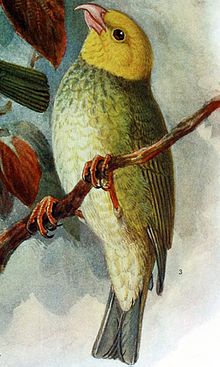ʻŌʻū
| ʻŌʻū | |
|---|---|
 |
|
| Keulemans illustration | |
| Scientific classification | |
| Kingdom: | Animalia |
| Phylum: | Chordata |
| Class: | Aves |
| Order: | Passeriformes |
| Family: | Fringillidae |
| Subfamily: | Carduelinae |
| Tribe: | Psittirostrini |
| Genus: |
Psittirostra Temminck, 1820 |
| Species: | P. psittacea |
| Binomial name | |
|
Psittirostra psittacea (Gmelin, 1789) |
|
The ʻōʻū (pronounced [ˈʔoːʔuː]) (Psittirostra psittacea), is a species of Hawaiian honeycreeper, that is endemic to the Hawaiian islands. It has a dark green back and olive green underparts; males have a yellow head while females have a green head. Its unusual beak seems to be adapted to feeding on the fruits of Freycinetia arborea. It has a strong flight which it uses to fly considerably distances in search of this Hawaiian endemic vine, but will eat other fruits, buds, flowers and insects.
Although formerly widespread and present throughout the island group, numbers have declined dramatically during the twentieth century. It may have been affected by habitat loss and introduced predators, but the main factor in its decline is probably avian malaria and fowlpox, transmitted by the mosquito. The bird is listed by the International Union for Conservation of Nature as being critically endangered, but there are no recent records, and it may be extinct.
The ʻōʻū is a large, plump forest bird measuring 17 centimetres (6.7 in) in length. Males have a bright yellow head, dark green back, and an olive-green belly. Females are duller with an olive-green head. TheʻŌʻū has a pink, finch-like bill and pink legs.
The breeding biology of this bird is unknown, although juveniles have been seen in June, suggesting a March to May breeding season. The ʻōʻū’s call is an ascending or descending whistle that may break into a sweet and distinct canary-like song.
Its unique bill was apparently adapted for feeding on the fruits of the ʻieʻie (Freycinetia arborea) vine, although when the fruiting season ended the ʻōʻū readily moved both up the slope and downslope in search of other foods, both native and introduced. In addition to fruits, it feeds on insects, and buds and blossoms of the ʻōhiʻa lehua (Metrosideros polymorpha). It was known to have been a nomadic forager that made strong flights to follow seasonally available fruit crops across a broad elevational gradient.
...
Wikipedia

